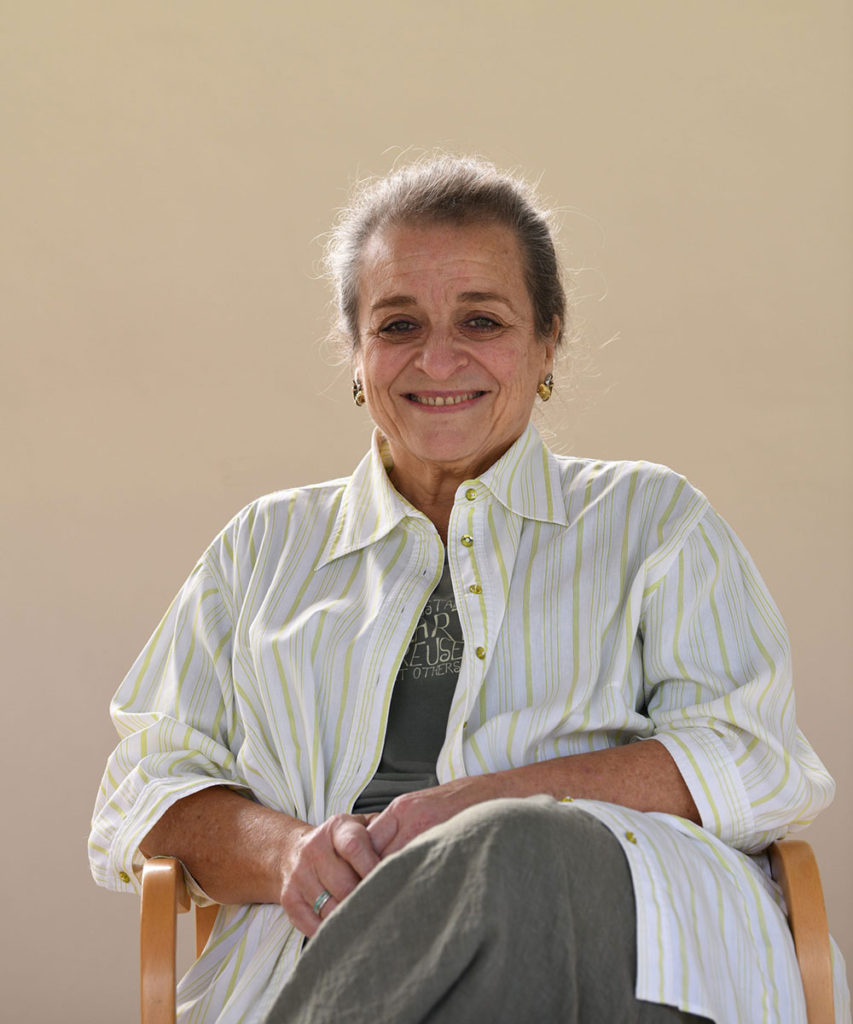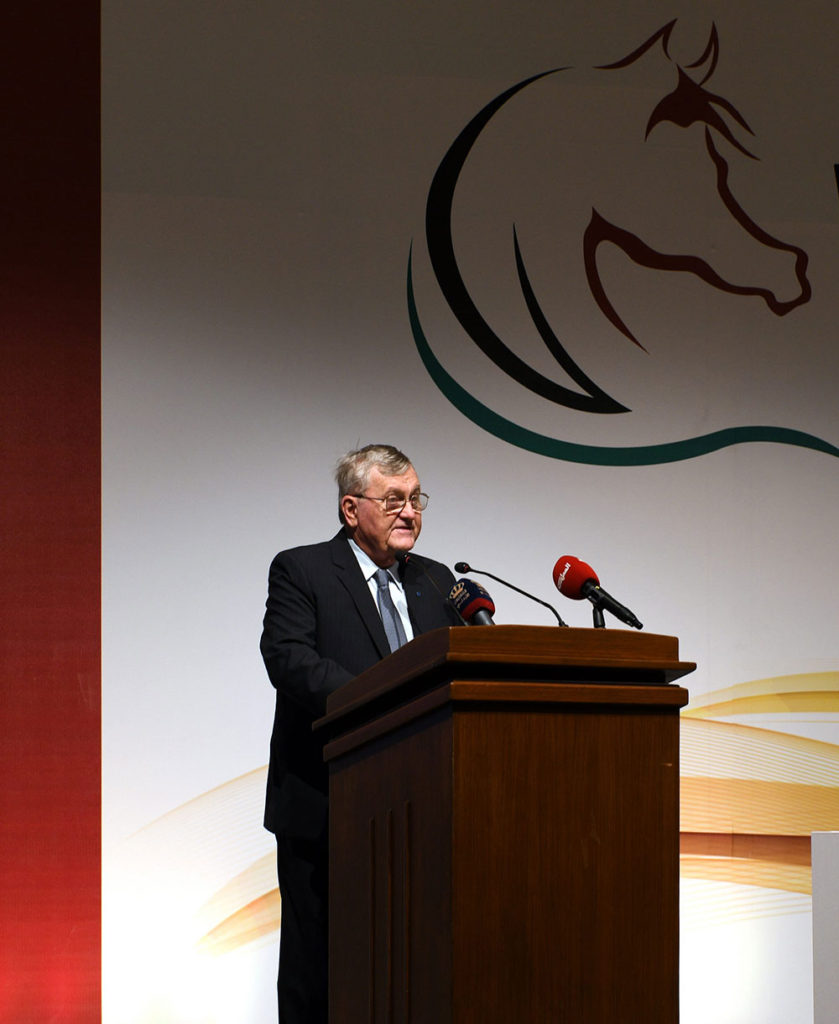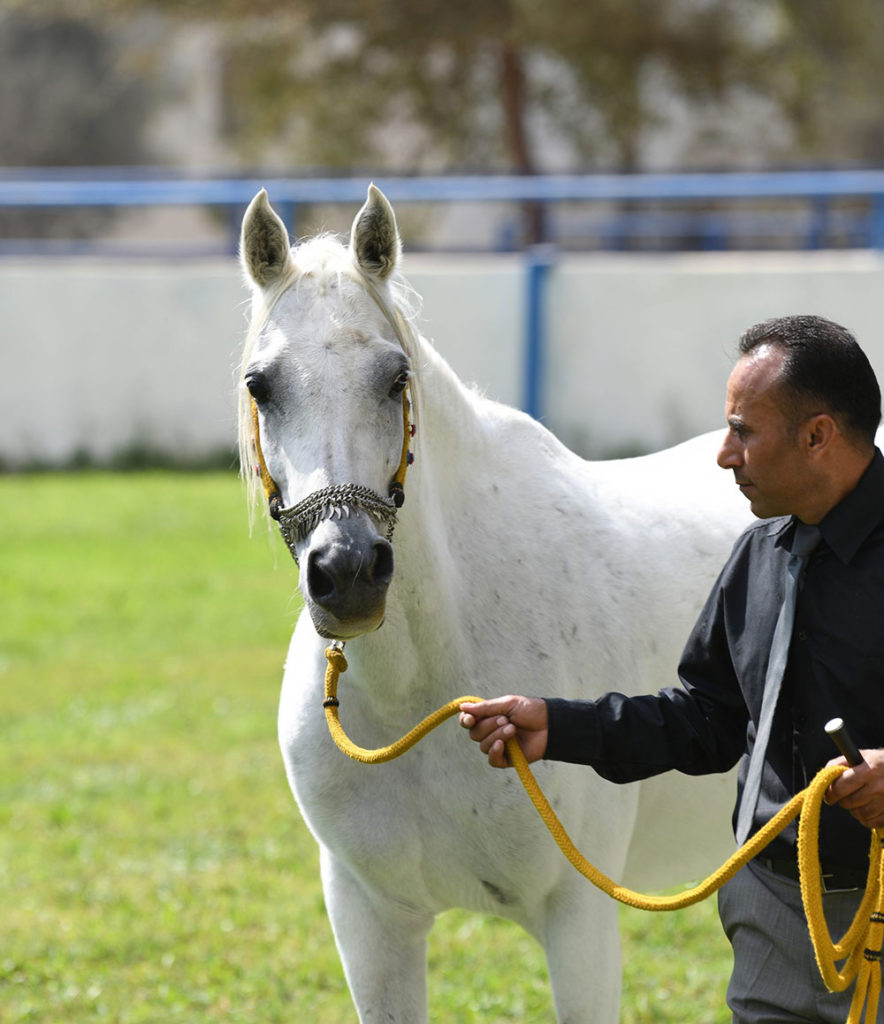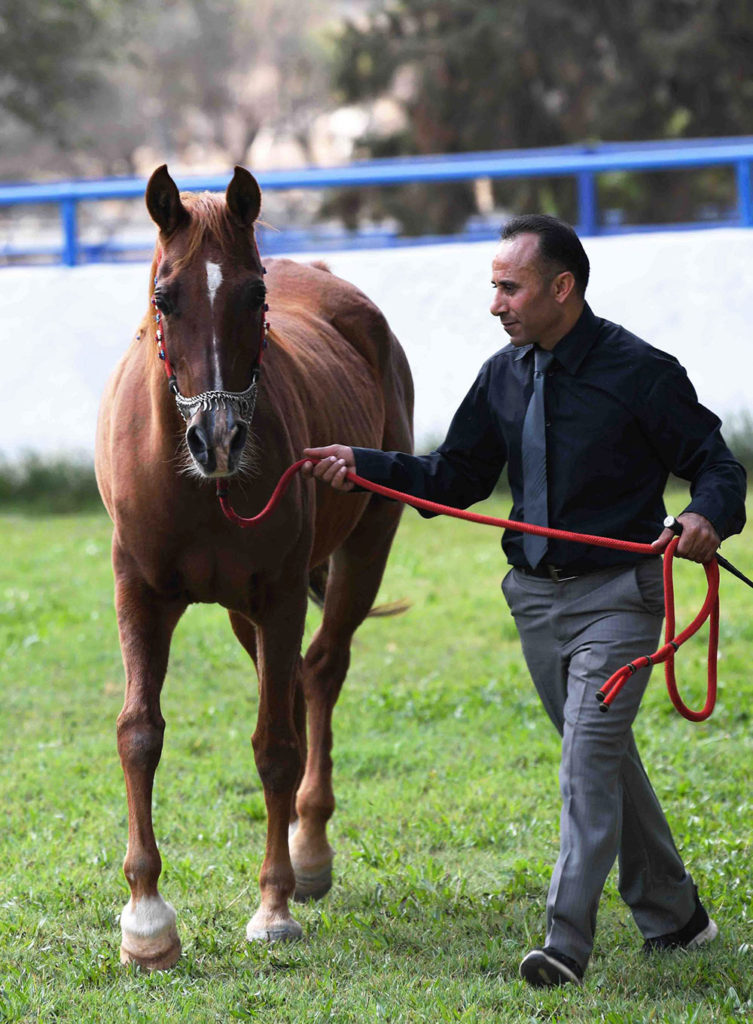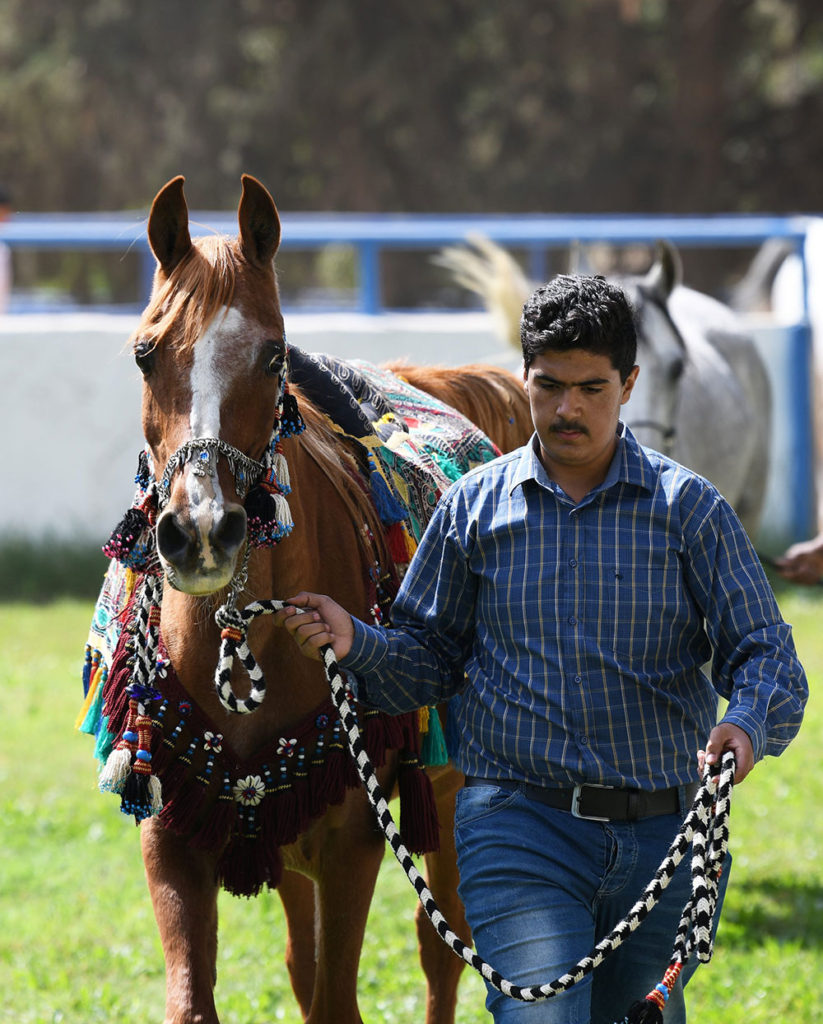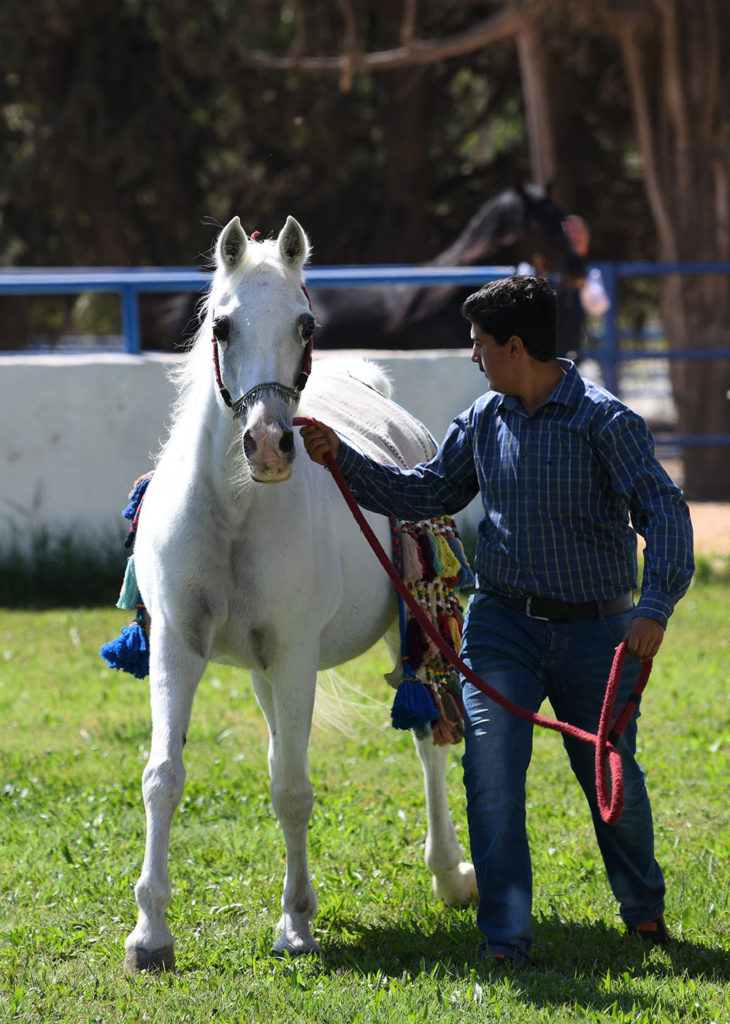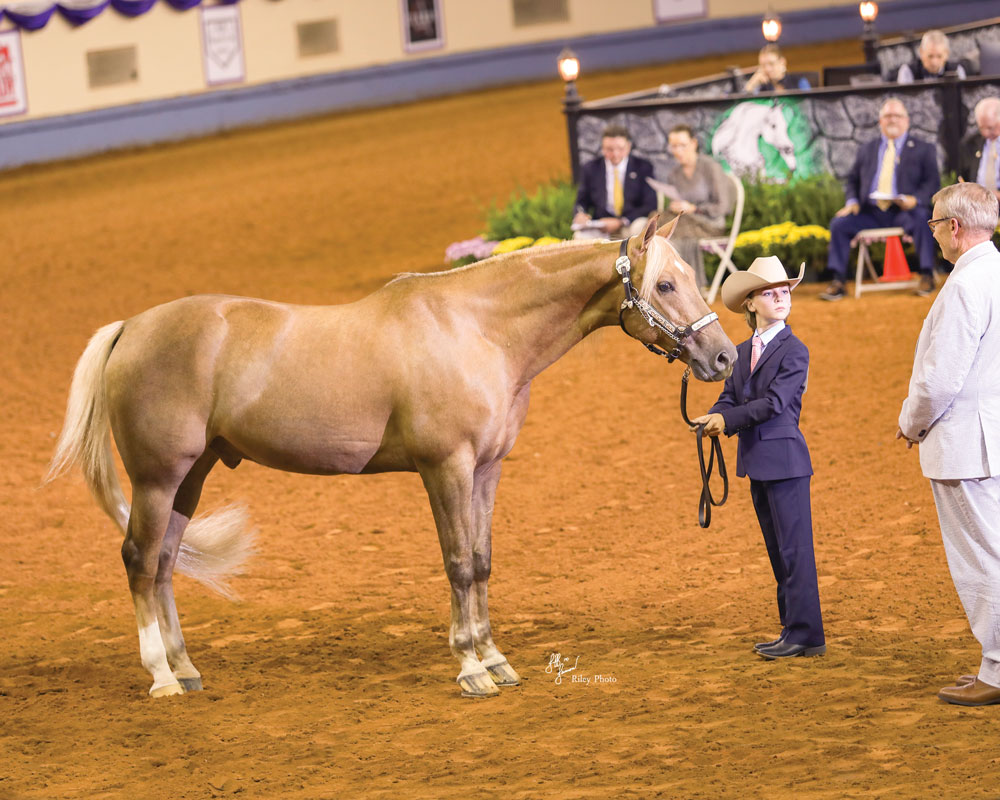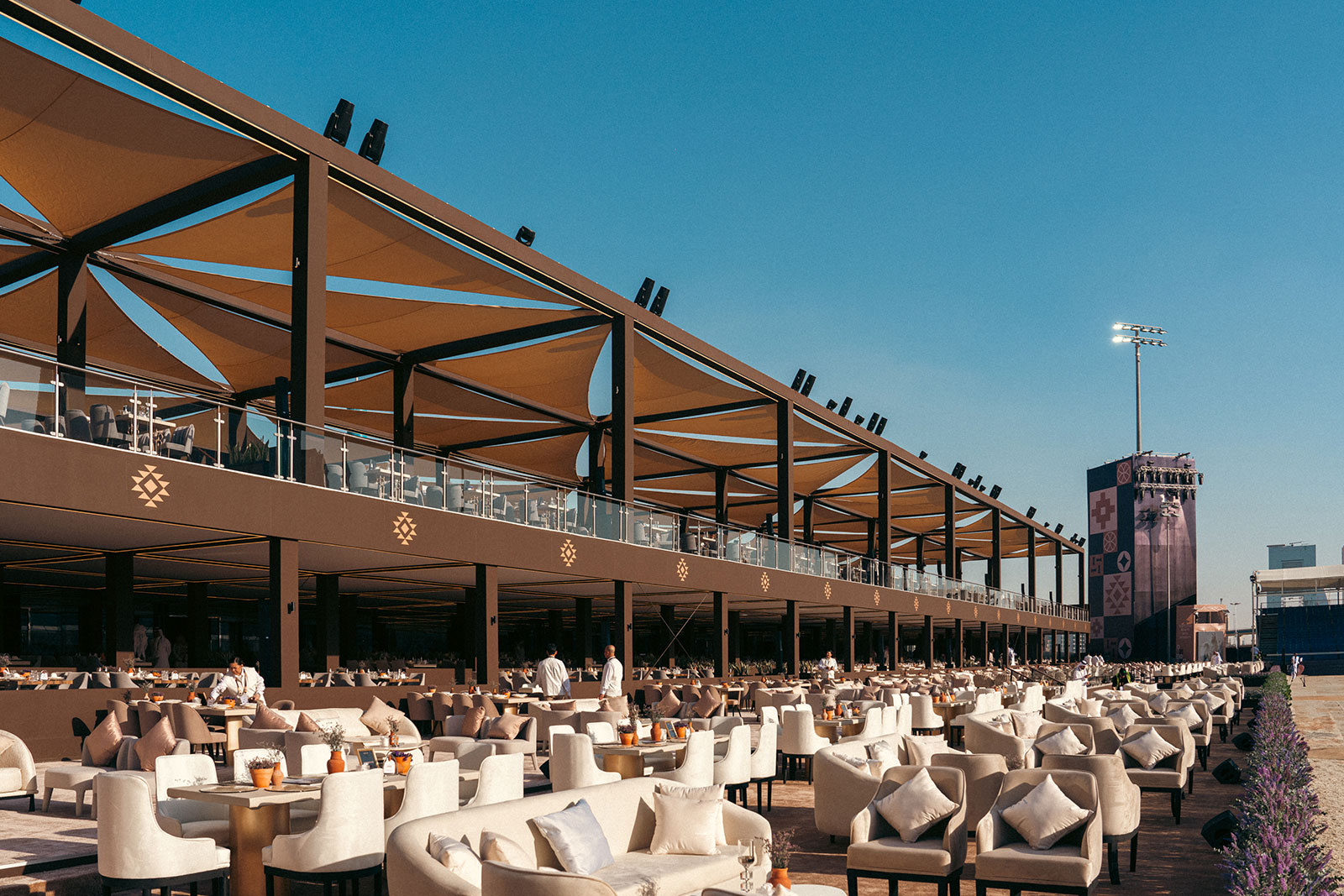Sunrise at Wadi Rum.
The beautiful stallion Hlayyil Ramadan (Kamar El Zaman x Haboub) is the Royal Stud’s pride and joy. The homebred stallion traces to the desert-bred war mare, Freiha. Now 27, this World Reserve Champion, famous for his huge eyes, looked marvellous and it was easy to see the stamp he has put on his outstanding progeny.
Two Monarcos DD imp BE daughters Hhoor (x Hasanaat Haneefah) 2008 and right Jeedah (x Jawaahir) 2010.
HRH Princess Alia Al Hussein at the Royal Stud.
Prince Rashid Bin Hassan, Princess Alia’s cousin, spoke about Jordan.
WAHO President Peter Pond.
Guest Speakers Peter Upton with Gudrun Waiditschka.
“All state studs have the advantage of continuity, so it is with the Royal Jordanian State Stud.”
The Jamila Family
Durar Al Hummar (Monarcos DD BE x Doonya) 2014 mare.
Diraar (Sadeeq x Durar Al Hummar) 2021 colt.
The Mashalla I Family
Shumookh (Hlayyil Ramadan) 2007 mare.
The Lubri II Family
Hafeedat Lateefah (Yaqout x Lutfyia) 2014 mare.
“We were captivated by so many beautiful horses, young and old, in show or paddock condition, sympathetically shown by the UK’s well-known handler Mark Gamlin and the excellent Royal Stables’ grooms and staff.”
The Faddah Family
Hafeedat Aysha (Shamekh Al Shaqab QA x Abir) 2004 mare.
The Selwa I Family
Aida (Jood x Atarah imp GB) 1999 mare.
The Al Hamama Family
Nafisa (Shamekh Al Shaqab imp QA x Nabeelah) 2000 mare.
Nafees Al Hummar (Eid Jaafar x Nafisa) 2018 stallion.
The Nasseb Family
Rahaf (Hlayyil Ramadan x Raheefah) 2000 mare.
Hasanaat Al Haneefah (Hlayyil Ramadan x Al Haneefah) 2002 mare.
The Nasseb Family
Jawaahir (Hlayyil Ramadan x Goleh Gola imp FR) 2001 mare.
Jameel (Monarcos DD imp BE x Jawaahir) 2011 stallion.
Almasa (Monarcos DD imp BE x Jawaahir) 2008 mare.
Rahaf at the Royal Stud.
Rescued Tiger at Al Ma’wa for Nature and Wildlife Reserve.
Story and Photos by Sharon Meyers
Hosted by the Royal Jordanian Equestrian Federation under the patronage of His Majesty King Abdullah II, Arabian horse lovers travelled from around the world to Amman for the twenty-fourth World Arabian Horse Organization (WAHO) Conference held October 2022.
HRH Princess Alia Al Hussein officially opened the Conference, saying it was their great pleasure to finally host WAHO in Jordan, adding that Jordan’s Arabian Stud Book was accepted in 1980. She concluded with heart-warming words. “Our special relationship with our wonderful, kind and empathetic Arabian horses unites people in a very unique way, which is why WAHO meetings are so harmonious.”
Princess Alia then introduced her cousin, Prince Rashid Bin Hassan, who entertained us with his personal perspective on Jordan. He emphasised the Jordanian tradition of welcoming all visitors, and gave an example of how Jordanians always help each other. During a recent devastating forest fire that encircled the Royal Stables, ordinary citizens joined the authorities by rushing to help stop the fire spreading and assisting in rounding up the precious horses which had escaped onto a busy main road, all coming together to greatly minimise what could have been a catastrophic event.
In his opening speech WAHO’s President, Peter Pond, reminded us that WAHO was founded on co-operation and friendship between individuals and between countries, across cultures, histories, and language. He said the unique family of WAHO gained its strength as an organization from continuity, goodwill and mutual respect, adding that whether those gathered together in Amman were registrars, administrators, breeders, owners, competitive or pleasure riders, all shared the same common interest in Arabian horses.
The WAHO Executive Committee (EC) Members, who put aside national interests to represent the interests of the Arabian horse as a whole, then introduced themselves. Between them, they have over 300 years of combined WAHO individual membership and 170 years of combined service as EC members, their knowledge and experience giving WAHO exceptional stability. Lady Georgina Pelham has retired as a full EC Member and is now an Emeritus member.
The interesting Delegate reports about activities in their countries always take up most of the first day. Peter Pond started by reporting that Bolivia is now a full Registering Authority Member of WAHO; Germany is the caretaker registry for Arabians in Albania and has nearly completed their registrations; and that after 20 years of inactivity due to difficult domestic circumstances, the Arab Horse Society of Zimbabwe had renewed their full membership with WAHO. The Delegates voted to confirm that Zimbabwe will act as the caretaker registry for the small number of Arabians in Lesotho. The Delegates also voted to confirm that Oman will act as the caretaker registry for Tanzania. China, which has seen a large number of imports, is still working with WAHO to prepare their first studbook.
Peter then mentioned the times over the years when wars between countries, or civil wars and political upheaval within countries, had affected some WAHO Member countries in the worst ways imaginable. He did not mention any countries by name, acknowledging that some of those present had lived, or were still living, through those times. He added that he was sure everyone agreed with the hope for peace to prevail everywhere. He also emphasized that since its inception, WAHO has been a totally non-political organization, and always will be.
Peter talked about Ukraine, an Applying Member of WAHO, whose horses were registered by Russia until the break-up of the Soviet Union. The Ukrainian Horse Breeders Association had nearly finished compiling their first independent Arabian studbook but, for obvious reasons, this work had to be suspended in February 2022. With the financial and practical aid raised by ongoing appeals by international equine organizations, coordinated by the Ukraine Equestrian Federation, all their energies have been going to considerable efforts, in very dangerous circumstances, to distribute aid, forage and feed to the horses of Ukraine and to move horses, when possible, to safer locations.
Moving on to the always interesting Delegates’ reports, many mentioned the negative after-effects of Covid and even severe weather events such as fires, drought and floods. It was encouraging to learn that foal registrations are actually increasing in several countries, and that halter and ridden shows, racing, performance classes and endurance remain popular in most countries, while activities such as dressage, show jumping, reining, tent pegging and sport horse events are growing in popularity. Some delegates made their presentations with visual aids, including France, Poland, Saudi Arabia, Turkey, and the UK, particular highlights being the fascinating film footage of Pakistan’s Remount Depot Mona and the lovely video from Saudi Arabia.
Delegates also reported on their own rules for Embryo Transfer (ET) and the number of foals per mare per year they allow to be registered. For many years WAHO has been encouraging its Members to educate their breeders on welfare issues for broodmares used for multiple ETs. As a few examples, France has recently put a limit on embryo transfer per mare per year, accepting the registration of only one ET foal plus one natural foal; Jordan no longer allows multiple ET; Poland accepts one ET foal plus one natural foal, but only if a purebred Arabian mare is the recipient mare for the ET foal.
The second day started with the Treasurer’s report. This was followed by the report from Xavier Guibert, Chairman of the interesting and productive WAHO World Registrars Meeting, including their important consensus that the mandatory WAHO rules on advanced assisted reproduction techniques should not be changed. Many Registries now have online studbooks or databases, and links to these will soon be available on the WAHO website www.waho.org.
Several comprehensive and fascinating Guest Speaker talks concluded the meeting. More detailed reports on these will be available in due course on the WAHO website.
Russell Ferris, C.E.O. of Weatherbys, which founded the first Thoroughbred Stud Book in 1791, reprised the talk he gave to the World Registrars’ Meeting. His topic is of interest to all registries, as printed books are being superseded by digital versions. He spoke about their cutting-edge registration technology, the importance of data and process integrity for centralised and accessible databases, and the latest options for harnessing the power of digital transformation.
Gudrun Waiditschka, Deidre Hyde and Dr. Astrid von Velsen-Zerweck shared the last presentation, illustrated with many images, “Preserving Our Heritage: the Importance and Relevance – Past, Present and Future of State, National, Royal, Military and Agricultural Studs.” Gudrun is a respected, widely travelled equestrian journalist and photographer who publishes her own magazine, “In The Focus;” Deirdre is an author and international judge with decades of experience as a stud manager; and Astrid is the President of the European State Studs Association and Director of the centuries-old Marbach State Stud, famous for its “silver herd” of Weil-Marbach Arabians.
Gudrun first covered the individual history and development of the European, Russian, and North African State Studs, with the reasons for their foundation and for breeding Arabian horses. Deirdre followed with a broad overview of the history, development, and influence of the Royal and State Studs in the Middle East and Western Asia, as well as the Remount stables and Government studs in Australia and the Americas. Astrid’s concluding and thought-provoking talk raised questions about the future of horse breeding and horse heritage in our modern societies, and the positive role the State Studs can play.
Peter Upton’s talk on the horses of the Bedouin tribes of Jordan
Peter Upton, the well-known author, artist, international judge, and authority on the history of the Arabian breed was the next speaker. With his intimate knowledge of The Royal Jordanian State Stud over decades, his entertaining talk “War Horse to Show Horse,” lavishly illustrated with old photos and his own paintings, covered the Stud’s origins and development.
Peter shared some history of the Bedouin tribes in Jordan, with fascinating stories about their horses and the Arab Revolt with the famous Lawrence of Arabia. He spoke about the Roala, one of the tribes of the Anazeh, long renowned for their Arab horses. The Roala sold at least 183 known Arab horses between the 1830s and 1930s to Abbas Pasha I, Ali Pasha Sherif, Baron von Fechtig, Davenport and the Blunts. Plus studs in Weil, Germany; Babolna, Hungary; Poland, Italy, Argentina, Spain and England. In 1854, British Army Captain Louis Nolan visited the Roala and the Wuld Ali tribe, and purchased 72 horses, plus others from the towns, for the Crimean War. Among other important horses purchased from the Roala were Rodania, who had a major influence at Crabbet Arabian Stud UK, and Muson, one of many horses that Homer Davenport imported to America in 1906. Another tribe’s, the Beni Sakhr, early exports included Dervish, a grey Kehilan presented to the British king in 1773, and Shagya, a grey 1830 Jilfan strain stallion who went to Babolna where he established a breed named after him. Many other tribes are also to be found in the deserts of Jordan: the Wuld Ali, the Howeitat, the Abu Tayah, Aduan, Da’aja and the Majali from Kerak.
Peter related some of his own experiences from his many visits to Jordan over the past years. “I was fortunate to meet Sheikh Jweiber, who had been the Emir’s Standard Bearer in the Arab Revolt. He was about 90 years old, quite a small dark man, immaculate in Arab robes. He spoke no English and did not read or write. Fortunately, I had with me a relative of Princess Alia’s to translate. Jweiber’s memory was truly amazing, and he was able to tell me much about the Arab Revolt and the horses that came with the Bedouin. He also described many of the Arab horses and mares, for they used both in battle, he assured me. Jweiber remembered the Keheileh mare, El Johara, who he was riding the day they besieged El Medina. Another he mentioned was the Keheilet Ajuz mare Freiha, who, in the battle of Turba, carried two men to safety. Later, Freiha was to become one of the original mares of The Royal Jordanian State Stud, which was founded by King Abdullah I.
“It records in the Jordanian Stud Book Volume 1 that Freiha and Jamila, of the Keheileh Krush strain, were among the mares and stallions which accompanied H.M. King Abdullah I north from the Hejaz,” continues Peter. “Five other mares were given to the King, two of which were gifts from the Sheikh of the Aduan tribe, Abd Al Majid, namely Faddah, a bay Managieh, and Abaya of the Abaya Umm Ejeres strain. A third mare named Selwa I, a chestnut of the Hamdanieh Simrieh strain, came from Abu Jamov of the Da’aja tribe. The last two mares that make the seven foundation mares of the Royal Stud, both bred by Dhewan Pasha Al Majali, Sheikh of the Al Majali, were Al Hamama of the Kubeysha strain, and Naseeb of the Umm Argub strain. So, we have the seven foundation mares of the Royal Jordanian State Stud.
“The stud also had six foundation stallions, some of whom came north from Mecca with Emir Abdullah. Others were horses he had bred. The last stallion listed as a foundation stallion was the desertbred Mehrez, of the Hamdani Simri strain. He was a superb horse with an interesting history. He was born in 1956, bred by Daoud Pasha Al Daghestani in Baghdad, where King Feysul’s grandson was the ruler at that time. When the family was assassinated, Mehrez was saved by a groom and came to Jordan.
“So, the Royal Jordanian State Stud flourished for thirty years until 1951 when tragedy struck. King Abdullah I was assassinated in the Great Mosque in Jerusalem. When his 16-year-old grandson Hussein became King in 1952, he faced a tremendous task and the Stud was not a priority. Fortunately, a veterinarian named Said Taha, a wonderful man, with the help of others worked to save the stud and its precious horses. In 1962 King Hussein appointed Santiago Lopez to manage the Stud. During this difficult period, some horses were lost. They actually found Gazelle pulling a plough; being a special mare of the Krush strain, they wanted her back and Santiago had to pay £60 to get her back.
“Under sound management the Stud was again safe, all seemed well. But then on the 5th of June 1967 the Six Day War began. The Stud, which was then situated at Shuna down by the River Jordan, was in the path of the advancing troops. So, Santiago, his wife Ursula, Said Taha, and the grooms, including Radi and Attar, realising that they and the horses were in great danger, had to get out. Riding the stallions, leading others, and with the rest set loose, they got away just in time. Climbing 3,000 feet up the mountains, and crossing deep wadis, they reached Amman after a 12-hour ordeal. The precious Arab horses were safe and new stud buildings and paddocks were built at Al-Hummar, north-west of Amman, where they remain to this day.
“It was felt that there was little need to widen the Stud’s genetic pool, but ultimately, in 1978, it was agreed to introduce two new stallions from England and Santiago chose Akhbar (Indian King x Bint Astreelia) and Magento (Manto x Fairy Magic). Akhbar in particular left many good offspring before retiring to the Jordan Mounted Police. In 1980 Santiago retired, only to return again in 1988. Princess Alia, known to us as the ‘Princess of the Arab Horse’ had from her earliest years been enamoured of horses. She spent much of her time at the Stud and was taught to ride by Ursula. Later, Princess Alia became Chair of the Stud’s Council and then took over as Director after the death of Santiago Lopez, and she still remains as Director.
“All state studs have the advantage of continuity, so it is with the Royal Jordanian State Stud. It has always aimed to retain the lines of the original foundation lines of the seven mares and the stallions but at the same time to improve the quality of the horses they breed.”
Peter’s talk was the best possible introduction to the special parade arranged for us at The Royal Jordanian State Stud the day after the WAHO General Assembly. It was such an honour to visit this oasis of calm on the outskirts of Amman. The Stud’s Director, HRH Princess Alia, together with Peter Upton and Dr. Marek Trela, were the commentators.
We were captivated by so many beautiful horses, young and old, in show or paddock condition, sympathetically shown by the UK’s well-known handler Mark Gamlin and the excellent Royal Stables’ grooms and staff. The horses were presented in family groups by their female lines, tracing to those seven mares Peter had described in his talk. Although of different strains, clear similarities could be seen within the families. Other bloodlines, mainly stallions but also a few mares, have been carefully added over the years, to widen the genetic pool while still retaining the characteristics the Stud is renowned for. We especially admired the noticeable features shared by all the horses, including their expressive natural movement, large well-placed eyes and charismatic but calm temperaments.
The parade ended with the Stud’s pride and joy, homebred stallion Hlayyil Ramadan (Kamar El Zaman x Haboub), descended from the desert-bred war mare, Freiha. Now 26, this former World Reserve Champion, famous for his huge eyes, looked marvellous and it was easy to see the stamp he has put on his outstanding progeny.
Chief sire Monarcos DD (Psytadel x Monogrammed Lady), imported from Belgium as an outcross in 2006, was not exhibited but we saw several exceptional descendants, including his captivating daughter Almasa (x Jawaahir), maternal granddaughter of Hlayyil Ramadan and a multi-show champion both in Europe and Jordan. Combining the original Jordanian mare bloodlines with Hlayyil Ramadan and Monarcos DD has certainly been a successful cross for the stud.
After a delicious al fresco lunch we visited one of the original stable yards, designed by former stud manager Santiago Lopez and his wife Ursula in the 1960s. It was a tribute to their gentle natures how calmly the horses accepted so many visitors to their stables, which encloses a large courtyard with a central six-sided water fountain. Ursula painted its unique and irreplaceable coloured tiles depicting horsemen riding spirited Arabians. This was certainly a special day, and one that all of us lucky enough to be present will never forget.
Social Events: Reunions with old friends and meeting new ones are always the icing on the WAHO Conference cake. Amman was no exception, with relaxed evening gatherings at various venues while enjoying a delectable culinary journey of Middle Eastern cuisine. During the outdoor dinner at the Amman Equestrian Center, hosted by the Royal Jordanian Equestrian Federation, we were treated to a fast-paced display of tent-pegging and a parade of local breeders’ many outstanding Arabians. Peter Pond presented the successful endurance mare Sahwat Al Wahhab AH (Najem Hala x Al Hoda) with her prestigious 2022 WAHO Trophy.
Tours: In a land steeped in history, the guided tours of Jordan’s national treasures such as the Citadel in Amman and the Roman ruins at Jerash, as well as Madaba, Mount Nebo, the Baptism site, Petra, Wadi Rum, Aqaba and the Dead Sea, were truly inspiring. But it was the visit to the Al Ma’wa for Nature and Wildlife Reserve at Jerash that was a special highlight. Founded in 2011 through a partnership between the Princess Alia Foundation and Four Paws, the 110-hectare sanctuary provides refuge for animals saved from the illegal wildlife trade, war zones or failed zoos. Rehabilitated animals which cannot be returned to their original country or released into the wild have a permanent life at the reserve. Veterinarian Dr. Marek Trela, former Director of Poland’s Janow Podlaski Stud and Vice-President of WAHO, has been the C.E.O. here since 2018. The Jordanian staff who care for the rescued tigers, lions, bears, hyenas, wolves, monkeys, and other wildlife are dedicated and knowledgeable. Their love for the animals shines through as you walk with them around the reserve, while listening to their stories of rescue and recovery.
Altogether it was a superb WAHO Conference and remarkable visit to Jordan, a very special country — together we shared in a friendly celebration of the Arabian horse and WAHO’s foundation 52 years ago. We hope you can join us at the next WAHO Conference to be held in Abu Dhabi, the United Arab Emirates in February 2025.









